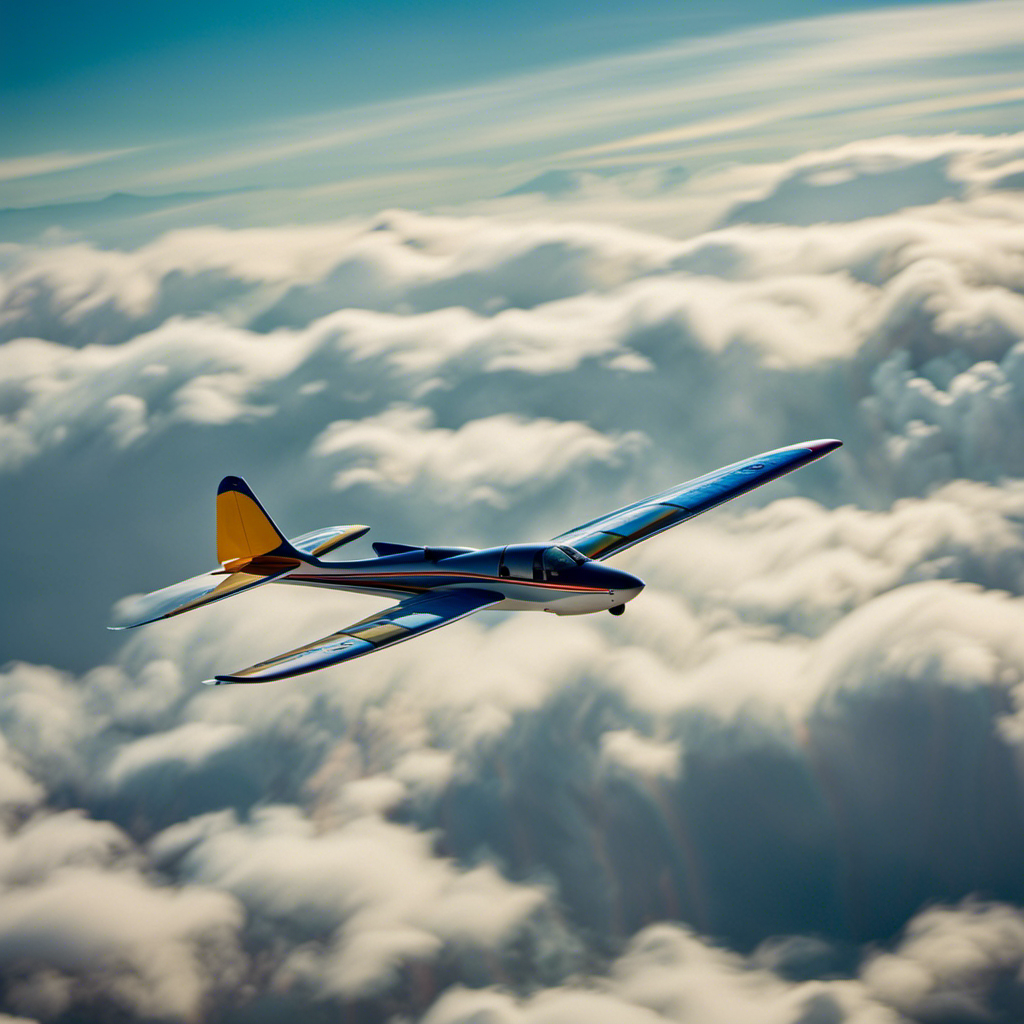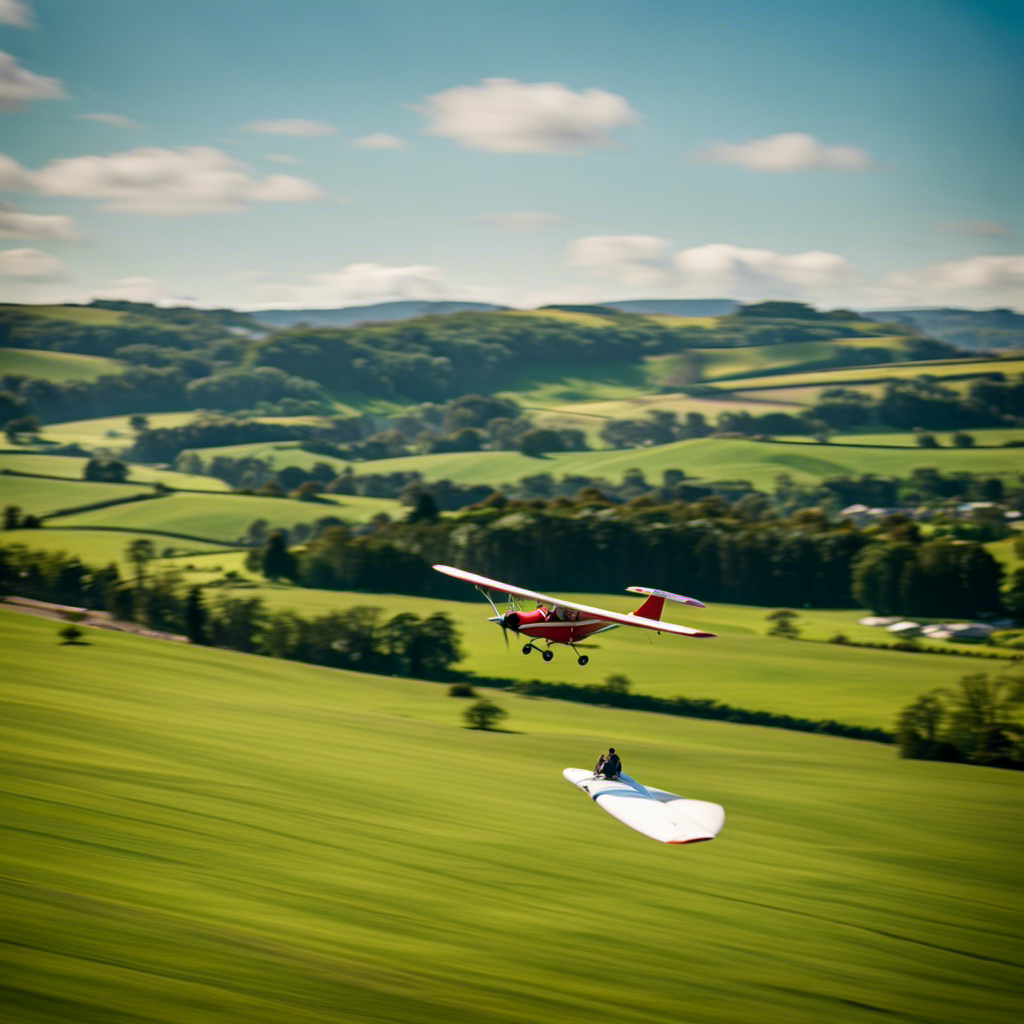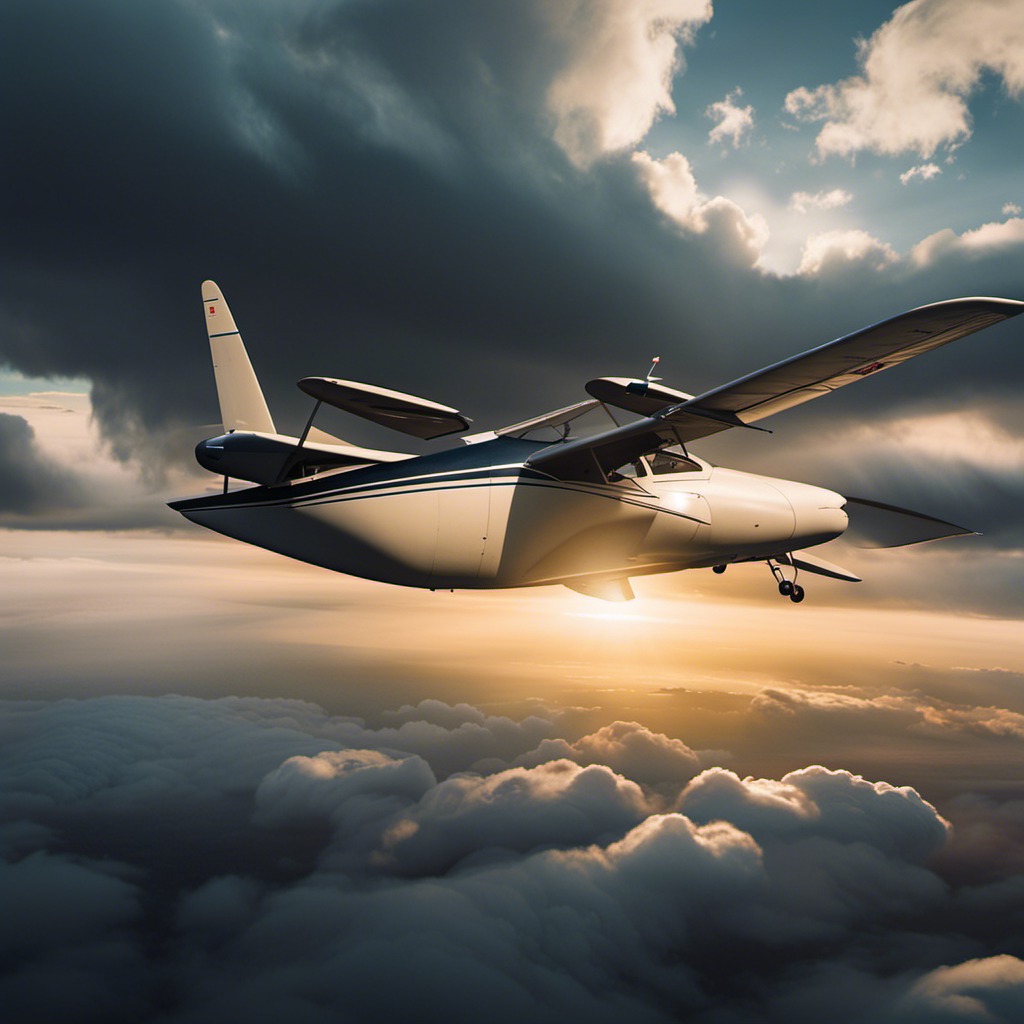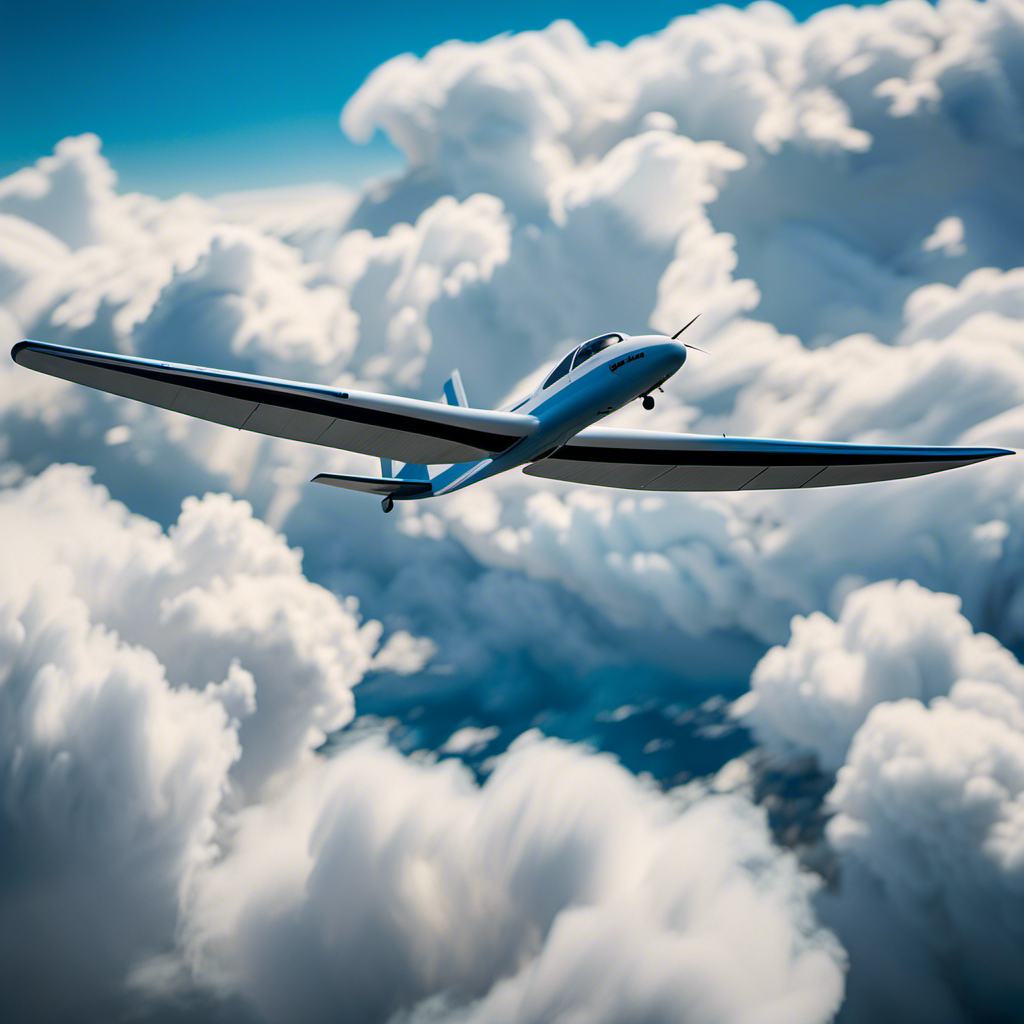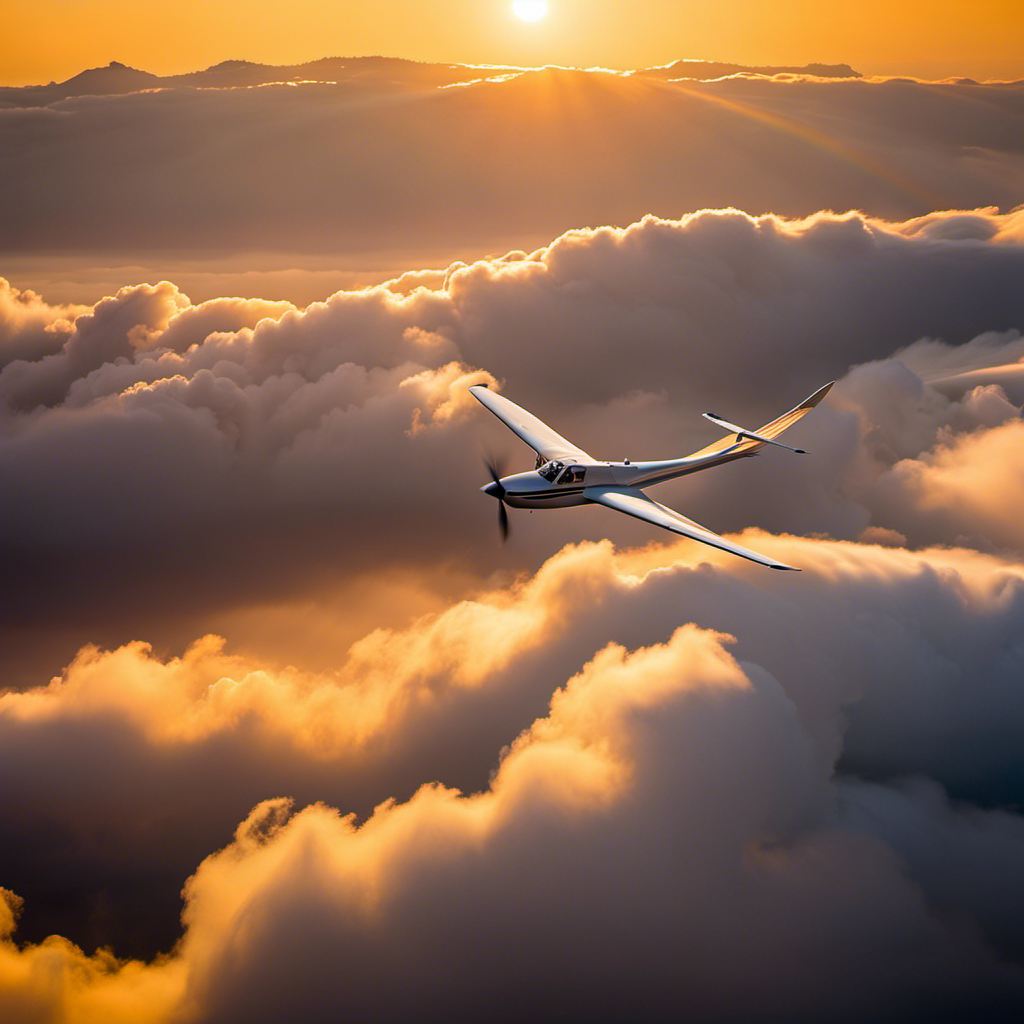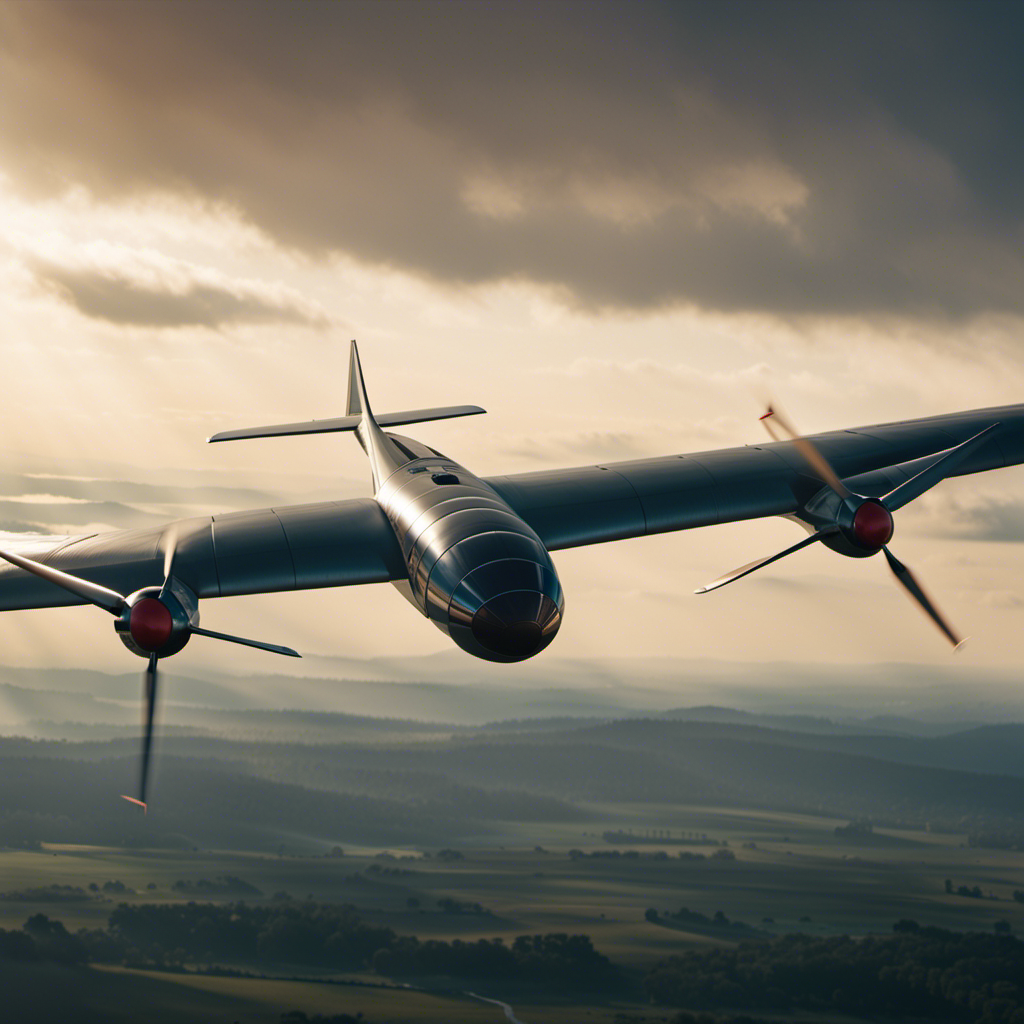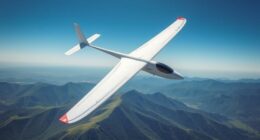As a passionate enthusiast of gliding, I am always impressed by the diverse range of gliders found within the gliding community. Whether it be gliders with motors or vintage models, there is a glider available to cater to every thrill-seeking adventurer.
Imagine soaring through the skies, feeling the wind against your face, and experiencing the freedom of flight. In this comprehensive guide, I will take you on a journey through the different types of gliders, providing you with the knowledge and expertise needed to navigate this exhilarating hobby.
So buckle up and get ready to explore the fascinating world of gliders!
Key Takeaways
- Aerobatic gliders require precision and skill to perform loops, rolls, spins, and hammerheads in competitions.
- Tandem gliders offer a memorable flying experience with limited control over flight and no extensive training required.
- Experimental gliders use cutting-edge designs and lightweight, strong materials like carbon fiber composites.
- Glider technology advancements contribute to enhanced flying experiences and pave the way for future innovations.
Motorized Gliders
If you’re looking for a glider that offers both the thrill of soaring through the skies and the convenience of a motor, motorized gliders are the perfect choice for you. Motorized gliders provide the best of both worlds, combining the freedom and grace of gliding with the power and control of an engine.
One of the advantages of motorized gliders is their ability to take off and land on their own, eliminating the need for a tow or winch launch. Additionally, the engine can be used to extend flight time and increase the range of the glider. However, there are also disadvantages to consider, such as the added weight of the engine, which can affect the glider’s performance and maneuverability.
When choosing the right engine for a motorized glider, factors such as power output, fuel efficiency, and weight must be taken into account.
Transitioning to the next section, hang gliders offer a different experience altogether.
Hang Gliders
Hang gliders are lightweight aircraft that allow pilots to soar through the air using wind currents. These exhilarating flying machines offer a unique experience, combining the freedom of flight with the thrill of adrenaline.
When it comes to hang gliding, safety is of utmost importance. Pilots must undergo thorough training and adhere to strict safety guidelines to ensure a secure and enjoyable flight.
Hang gliding competitions also play a significant role in the hang gliding community. These events showcase the skills and expertise of pilots from around the world, pushing the boundaries of their abilities while promoting camaraderie among participants.
As we transition to the next section about radio-controlled gliders, it’s important to note that these miniature aircraft provide a different kind of flying experience, allowing enthusiasts to take to the skies without leaving the ground.
Radio-Controlled Gliders
When flying radio-controlled gliders, you’ll have complete control over the aircraft as you maneuver through the air using the remote control. Radio-controlled gliders, also known as RC gliders, have become increasingly popular in competitions due to their versatility and precision.
One advantage of using radio-controlled gliders in competitions is the ability to perform complex aerobatic maneuvers with ease. With the remote control in hand, you can execute precise turns, loops, and dives, showcasing your skill and control.
Additionally, RC gliders offer the advantage of being able to fly in various weather conditions, including windy conditions, providing a challenging yet exciting experience for pilots.
However, it’s important to note that using radio-controlled gliders in competitions also has its disadvantages. They can be more expensive compared to other glider types, and their reliance on batteries means limited flight time.
Despite these drawbacks, the thrill and control offered by radio-controlled gliders make them a popular choice for competitive gliding.
Moving on to sailplanes…
Sailplanes
Sailplanes, also known as gliders, offer a thrilling and serene flying experience as they soar through the air without the need for an engine. These elegant aircraft have a rich history and are often used in competitive events known as sailplane competitions. These competitions test the pilot’s skill in navigating thermals and other atmospheric conditions to maximize their flight time and distance.
The history of sailplanes dates back to the late 19th century when Otto Lilienthal, a German aviation pioneer, made significant advancements in glider design. Since then, sailplanes have evolved to become sophisticated and efficient machines, capable of staying aloft for hours and even crossing great distances.
Now, let’s transition to the next topic, paragliders, which offer a different kind of flying experience.
Paragliders
If you’re looking for a thrilling and unique flying experience, paragliders provide an exhilarating way to soar through the sky. These lightweight, foot-launched aircraft offer a sense of freedom and adventure like no other. When it comes to comparing paragliders, there are several factors to consider, including wing size, aspect ratio, and safety measures. To make it easier for you, here’s a comparison table showcasing some popular paragliders:
| Paraglider Model | Wing Size | Aspect Ratio | Safety Measures |
|---|---|---|---|
| Model A | Medium | High | Reserve chute |
| Model B | Large | Medium | Reinforced lines |
| Model C | Small | Low | Anti-collapse system |
When choosing a paraglider, it’s crucial to prioritize safety. Always check for proper certification, inspect the equipment regularly, and follow recommended safety guidelines. Now, let’s move on to the next section and explore ultralight gliders, a different type of flying machine that offers its own unique experience.
Ultralight Gliders
Moving on from paragliders, let’s explore the world of ultralight gliders. These lightweight aircraft offer a thrilling and liberating flying experience. However, it is essential to take safety precautions when operating them.
First and foremost, ensure that you have received proper training and have a thorough understanding of the glider’s controls and mechanics. Always check the weather conditions before taking off, as strong winds can compromise your safety. Additionally, wearing a helmet and a sturdy harness is crucial for your protection.
Now, let’s talk about some popular ultralight glider models. The Swift Lite and the Airborne XT-912 are two highly sought-after options known for their maneuverability and stability. These gliders are designed to provide an enjoyable and safe flying experience.
Transitioning to our next section, let’s unravel the charm of vintage gliders.
Vintage Gliders
When exploring vintage gliders, you’ll discover the rich history and timeless beauty of these classic aircraft. Vintage glider restoration and collecting vintage gliders have become popular hobbies among aviation enthusiasts. Here are four reasons why vintage gliders hold a special place in the hearts of collectors:
-
Historical significance: Vintage gliders provide a window into the past, allowing us to appreciate the technological advancements and design evolution of aviation.
-
Preservation of heritage: Restoring vintage gliders helps preserve our aviation heritage, ensuring that future generations can experience the joy of flying these remarkable machines.
-
Unique craftsmanship: Vintage gliders showcase exquisite craftsmanship and attention to detail, with their elegant wooden frames and fabric-covered wings.
-
Connection to nature: Gliding in a vintage glider offers a serene and intimate flying experience, allowing you to soar through the sky powered only by the forces of nature.
Now, let’s move on to the next section about aerobatic gliders, where we’ll explore the thrilling world of high-performance maneuvers and adrenaline-pumping flights.
Aerobatic Gliders
To experience the exhilarating world of aerobatic gliders, you’ll be amazed at the incredible stunts and maneuvers these high-performance aircraft can perform. Aerobatic gliders are specifically designed to execute a wide range of breathtaking aerial maneuvers that push the boundaries of physics. These gliders are used in aerobatic competitions where pilots showcase their skills and creativity.
From loops and rolls to spins and hammerheads, aerobatic maneuvers require precision, skill, and a deep understanding of flight dynamics. Pilots master these maneuvers through rigorous training and practice, honing their ability to push the glider to its limits. The combination of speed, grace, and control displayed by these gliders is truly awe-inspiring.
Transitioning from the daring world of aerobatic gliders, let’s explore the realm of tandem gliders.
Tandem Gliders
If you’re looking for an unforgettable flying experience, tandem gliders offer a unique opportunity to soar through the sky with a knowledgeable instructor by your side. Tandem gliders have several benefits that make them an appealing choice for many enthusiasts.
First and foremost, flying in a tandem glider allows you to experience the thrill of gliding without the need for extensive training or a pilot’s license. The presence of an experienced instructor ensures your safety and provides valuable guidance throughout the flight.
However, there are a few drawbacks to consider. Tandem gliders can be quite expensive, and the limited space can make it less comfortable for some individuals. Additionally, the reliance on an instructor means that you have less control over the flight. Safety considerations include ensuring that the instructor is properly certified and that the glider is well-maintained.
Now, let’s delve into the exciting world of experimental gliders.
Experimental Gliders
As someone with a deep interest in gliding, I am excited to delve into the world of experimental gliders.
In this discussion, we will explore the cutting-edge designs and innovations that have been developed for these remarkable aircraft.
Additionally, we will learn about the extensive research and development behind experimental gliders, giving us a glimpse into the meticulous process that goes into creating these marvels of engineering.
Explore the cutting-edge designs and innovations in experimental gliders
Check out the latest experimental gliders to see the cutting-edge designs and innovations in action. These gliders are pushing the boundaries of aviation with their use of cutting-edge materials and futuristic designs.
One of the key advancements in experimental gliders is the use of lightweight yet strong materials, such as carbon fiber composites, which allow for maximum maneuverability and efficiency. The futuristic designs of these gliders also contribute to their performance, with sleek and aerodynamic shapes that minimize drag and optimize lift.
These innovations not only enhance the overall flight experience but also pave the way for future advancements in aviation.
In the next section, we will delve into the research and development behind these experimental gliders and learn about the exciting breakthroughs that are shaping the future of gliding.
Learn about the research and development behind experimental gliders
To understand the research and development behind experimental gliders, you should explore the innovative techniques and technologies that have revolutionized the field. It is through thorough research methods and technological advancements that these gliders have been able to push the boundaries of flight.
Here are some key factors that contribute to the advancements in experimental gliders:
-
Aerodynamic modeling and simulation: By using advanced computer modeling and simulation techniques, researchers can optimize the design of gliders for maximum performance and efficiency.
-
Material science: The use of lightweight and high-strength materials, such as carbon fiber composites, allows for stronger and more maneuverable gliders.
-
Propulsion systems: Experimental gliders often incorporate cutting-edge propulsion systems, such as electric motors or jet engines, to enhance their performance.
-
Avionics and instrumentation: Sophisticated avionics systems and precise instrumentation enable researchers to collect valuable data during test flights, aiding in further development.
-
Autonomous capabilities: Advancements in artificial intelligence and autonomous systems have allowed for the development of experimental gliders that can fly without human input, opening up new possibilities for research.
Understanding the regulations and certifications for flying experimental gliders is crucial to ensure safety and compliance.
Understand the regulations and certifications for flying experimental gliders
If you want to fly experimental gliders, you need to familiarize yourself with the regulations and certifications that ensure safety and compliance.
The regulations for experimental gliders are in place to protect both the pilot and the public. These regulations cover a range of aspects, including aircraft design, construction, and modifications.
Before taking to the skies, it is important to ensure that your glider meets all the necessary requirements and has received the appropriate certifications. By adhering to these regulations, you can have peace of mind knowing that your glider is safe and reliable.
Flying experimental gliders also comes with a number of benefits. These gliders often offer improved performance and innovative features that can enhance your flying experience. Additionally, flying experimental gliders allows you to be part of the cutting-edge advancements in glider technology.
Frequently Asked Questions
What are the safety regulations and requirements for flying gliders?
Safety regulations and requirements for flying gliders include age restrictions, with most countries requiring pilots to be at least 14 years old. Other regulations cover pilot training, medical certifications, and adherence to specific flight procedures to ensure safe operations.
How long does it take to learn how to fly a glider?
Learning to fly a glider typically takes several months, depending on individual progress and frequency of lessons. I can provide information on learning techniques and cost factors to help you get started in this thrilling aviation adventure.
Are there any age restrictions for flying gliders?
Age restrictions for flying gliders vary by country, but in general, there is no upper age limit. However, younger pilots must meet certain training requirements and may need parental consent. Safety and competency are the top priorities for all glider pilots.
Can gliders be used for transportation or are they strictly for recreational purposes?
Gliders can be used for transportation, although they are primarily used for recreational purposes. They have the potential to be an economical mode of travel, with a minimal environmental impact.
Are there any specific weather conditions or limitations for flying gliders?
Weather conditions for glider flying can greatly impact the safety and performance of the aircraft. Strong winds, turbulence, and poor visibility are all factors that can limit glider flying. It is crucial for pilots to be aware of these limitations and monitor weather conditions closely.
Conclusion
In conclusion, gliding is a thrilling sport with a wide array of options to choose from. Whether you prefer the motorized gliders for a powerful experience or the vintage gliders for a touch of nostalgia, there is something for everyone.
So strap on your goggles, hop into the cockpit, and take to the skies! Don’t let fear hold you back; embrace the freedom and exhilaration that gliding brings. Remember, as they say, ‘Yolo!’
So why not go out there and fly like there’s no tomorrow?
